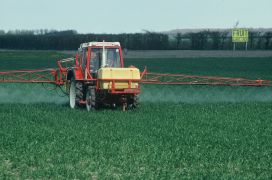| Both sides previous revisionPrevious revisionNext revision | Previous revisionLast revisionBoth sides next revision |
| capri:concept:supply [2023/06/02 08:33] – [Overview] gocht | capri:concept:supply [2023/06/02 09:24] – [Model calibration and simulation response] gocht |
|---|
| ==== Overview ==== | ==== Overview ==== |
| |
| {{ :capri:concept:nuts2.jpg?300|}}The supply module comprises about [[capri:concept:activities| 40 activities]] for each of the around 280 regions (at the so-called NUTS-2 level covering EU27, Norway, Western Balkans and Turkey) or about 2500 farm type models for EU27 (the remaining regions continue to operate at regional level), and includes about [[:capri:concept:outputs|50 inputs and outputs]]. Each independent model maximises regional agricultural income at given prices and subsidies, subject to constraints on land, policy variables and feed und plant nutrient requirements in each region. | {{ :capri:concept:nuts2.jpg?300|}}The supply module comprises about [[:capri:concept:activities|50 crop and animal activities]] for each of the around 280 regions (at the so-called NUTS-2 level covering EU27, Norway, Western Balkans and Turkey) or about 2500 farm type models for EU27 (the remaining regions continue to operate at regional level), and includes about [[:capri:concept:outputs|50 inputs and outputs]]. Each independent model maximises regional agricultural income at given prices and subsidies, subject to constraints on land, policy variables and feed und plant nutrient requirements in each region. |
| |
| //Income// is defined as the gross value added (GVA) at producer prices plus direct subsidies (premiums). Costs neither included in the GVA nor covered by the restrictions in the NLP models are captured by a quadratic cost function. | //Income// is defined as the gross value added (GVA) at producer prices plus direct subsidies (premiums). Costs neither included in the GVA nor covered by the restrictions in the NLP models are captured by a quadratic cost function. |
| The simulation response of the models depends on the interplay of the contraints and the objective function. Given the relatively small number of contraints directly impacting on the allocation of the production activities, the simulation response is too a large extent depending on the parametrization of the quadratic terms of the cost function. | The simulation response of the models depends on the interplay of the contraints and the objective function. Given the relatively small number of contraints directly impacting on the allocation of the production activities, the simulation response is too a large extent depending on the parametrization of the quadratic terms of the cost function. |
| |
| The slope terms of the cost function are either estimated from time series analysis ([[http://hss.ulb.uni-bonn.de/2007/1157/1157.pdf|Jansson 2007]]) or derived from exogenous elasticities. The models may hence be seen as a kind of hybrid approach combining features from traditional programming models with dual econometric estimation (see also [[http://www.ilr1.uni-bonn.de/agpo/staff/heckelei/heckelei_hab.pdf|Heckelei 2002]]). The cost functions' constant terms let the models calibrate to a given vector of technical coefficients, levels of the production activities, prices and subsidies. One set of parameters is generated to let the regional models calibrate to a three-year average around the base year, another to ensure calibration to the reference run. | The slope terms of the cost function are either estimated from time series analysis ([[http://hss.ulb.uni-bonn.de/2007/1157/1157.pdf|Jansson 2007]]) or derived from exogenous elasticities. The models may hence be seen as a kind of hybrid approach combining features from traditional programming models with dual econometric estimation (see also [[http://www.ilr1.uni-bonn.de/agpo/staff/heckelei/heckelei_hab.pdf|Heckelei 2002]]FIXME). The cost functions' constant terms let the models calibrate to a given vector of technical coefficients, levels of the production activities, prices and subsidies. One set of parameters is generated to let the regional models calibrate to a three-year average around the base year, another to ensure calibration to the reference run. |
| |
| ==== Environmental indicators and restrictions ==== | ==== Environmental indicators and restrictions ==== |


